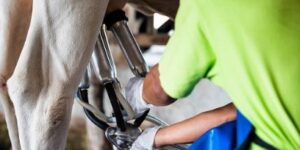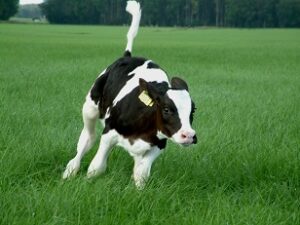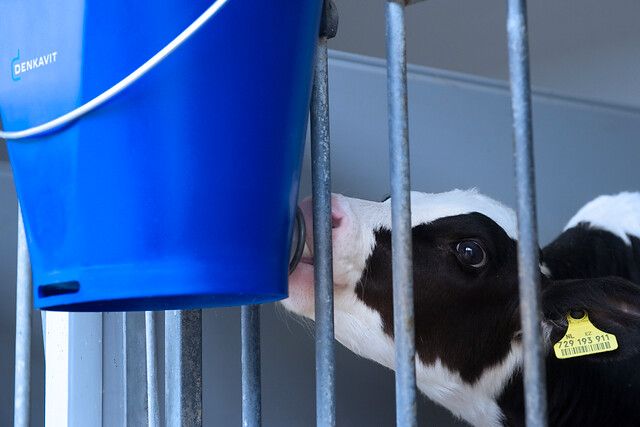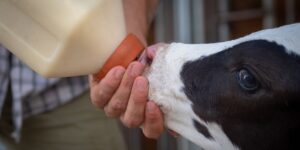Tools for achieving an optimal climate for rearing calves at < 15 °C
 Rearing calves need a comfortable climate, but what exactly does that entail? The thermoneutral comfort zone of a calf serves as a reference for the optimal ambient temperature. During the calf’s first month of life a minimum ambient temperature of 15 °C is defined as the lower critical temperature (LCT). Below this temperature, the calf uses extra energy to maintain optimal body temperature. Attention points and tools for creating an as comfortable environment as possible for your calves are explained in this news item.
Rearing calves need a comfortable climate, but what exactly does that entail? The thermoneutral comfort zone of a calf serves as a reference for the optimal ambient temperature. During the calf’s first month of life a minimum ambient temperature of 15 °C is defined as the lower critical temperature (LCT). Below this temperature, the calf uses extra energy to maintain optimal body temperature. Attention points and tools for creating an as comfortable environment as possible for your calves are explained in this news item.
A higher risk of draught in colder weather
An absolute temperature of 15 °C is not strictly required for calves, but prevention of draught and cold air flow is essential in lower temperatures. Draught is created when there is a difference between the barn temperature and the incoming air, relative to airspeed. The colder the air, the higher the chance of draught having detrimental consequences. If the incoming air is below 15 °C, extra attention must be given to draught and the risk of cold air flow. Consider the following points:
- A loft or crawl space can block or guard against cold air, but do not make it too low
- Insulation of the roof and front of the calf house prevents cold air pockets caused by cooling of air on the inside
- The way in which an open outlet over calves up to 4 months of age is constructed is critical
“With a good igloo, there is minimum difference in temperature and a minimal chance of draught”
Limiting heat loss in winter when the temperature is below 15 °C
Consider the following points of interest to ensure the calf loses as little heat as possible: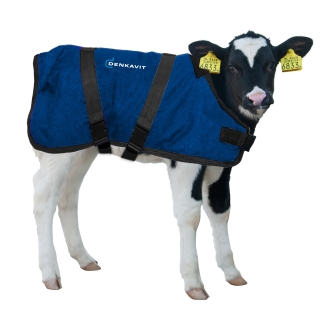
- A dry bed: use flax or sawdust beneath the straw to effectively absorb moisture
- Provide sufficient straw for the calf to lie in a “nest”
- Use a heat lamp for the first few days.
- Use of a bodywarmer for calves up to 4 weeks of age decreases heat loss
Ventilation: adapt capacity for colder months
 Good ventilation is important to remove harmful gases, moisture and infectious air and to introduce clean air. For all ventilation systems, whether natural or mechanical, it is important to adapt the capacity to the requirement in the colder months. At lower temperatures, less ammonia will be released from the layer of straw/manure. The need for ventilation will thus be lower. You should therefore also consider adjusting the air inlet.
Good ventilation is important to remove harmful gases, moisture and infectious air and to introduce clean air. For all ventilation systems, whether natural or mechanical, it is important to adapt the capacity to the requirement in the colder months. At lower temperatures, less ammonia will be released from the layer of straw/manure. The need for ventilation will thus be lower. You should therefore also consider adjusting the air inlet.
- Adapt the size of the inlet opening to the heat production/ventilation capacity
- Provide a cover or windbreak mesh to limit the effect of the wind
- If desired, incoming air can be preheated in cold weather circumstances
Practical reference: “The presence of spider webs in the barn provides an indication for airspeed. Are hardly any spider webs visible, or do they show quite some movement? In that case airspeed is likely to be high. Another practical indicator is a short thread hung over the air inlet. Does it move quickly, or only little ? This simple tool may provide an understanding of ventilation issues which otherwise would stay unnoticed.”
Effect of climate on the health of the calf
The climate has a big effect on the health and growth of the calf. Denkavit shares a great deal of knowledge regarding climate and ventilation with the veal, pig, goat, and dairy livestock sectors. Do you feel the climate for the rearing calves in your farm could be improved? Or do you have a question about housing? Then feel free to contact our youngstock specialists via export@denkavit.nl or fill in the contact form below.



